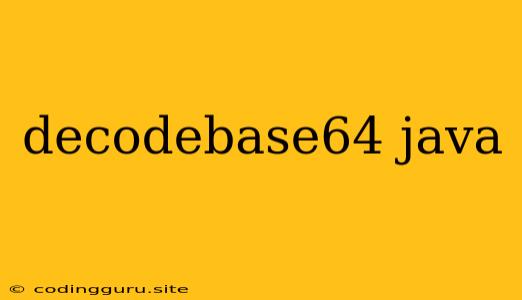Decoding Base64 in Java: A Comprehensive Guide
Base64 encoding is a widely used technique for representing binary data in a textual format. It's especially useful when transmitting data over channels that primarily handle text, like emails or web requests. While encoding data into Base64 is relatively straightforward, decoding it back to its original binary format requires a bit more attention. This guide delves into the intricacies of decoding Base64 in Java, providing you with the knowledge and tools to confidently handle this essential task.
Why Decode Base64?
Before diving into the specifics of decoding, let's understand why this process is crucial. Base64 encoding converts binary data into a text representation. This is particularly helpful when:
- Transmitting data over text-based channels: Email clients, for instance, handle plain text better than raw binary data.
- Storing binary data in text-based formats: Databases and configurations often work best with text.
- Sharing data in a human-readable format: While Base64 might seem like gibberish, it's easier to copy and paste compared to raw binary data.
However, the encoded data is just a representation of the original binary. You'll need to decode it to access the actual binary content, whether it's an image, a PDF document, or any other type of data.
The Fundamentals of Base64 Decoding in Java
Java provides a built-in mechanism for handling Base64 decoding. Let's explore how this works:
-
The
java.util.Base64Class: Java'sjava.util.Base64class is your primary tool for working with Base64 encoding and decoding. It offers static methods that allow you to perform these operations directly on byte arrays. -
The
decodeMethod: The key method for decoding isBase64.getDecoder().decode(String s). This method takes a Base64-encoded string as input and returns a byte array containing the original binary data.
Example:
import java.util.Base64;
public class Base64Decoder {
public static void main(String[] args) {
// Base64 encoded string
String encodedString = "SGVsbG8sIHdvcmxkIQ==";
// Decode the string
byte[] decodedBytes = Base64.getDecoder().decode(encodedString);
// Convert the decoded bytes to a String
String decodedString = new String(decodedBytes);
System.out.println("Decoded String: " + decodedString);
}
}
Output:
Decoded String: Hello, world!
Handling Decoding Errors
While the decode method is designed to gracefully handle potential errors during decoding, it's crucial to anticipate and address them appropriately.
-
Invalid Input: The most common error occurs when the provided input is not a valid Base64 string. This can happen due to typos, missing padding characters, or invalid characters being included.
-
Catching
IllegalArgumentException: Java'sBase64class throws anIllegalArgumentExceptionif the input string is invalid. You can use atry-catchblock to handle this exception and provide a suitable error message or alternative behavior.
Example:
import java.util.Base64;
public class Base64DecoderWithErrorHandling {
public static void main(String[] args) {
// Invalid Base64 encoded string
String invalidEncodedString = "SGVsbG8sIHdvcmxk"; // Missing padding characters
try {
byte[] decodedBytes = Base64.getDecoder().decode(invalidEncodedString);
System.out.println("Decoded String: " + new String(decodedBytes));
} catch (IllegalArgumentException e) {
System.err.println("Error: Invalid Base64 encoded string: " + e.getMessage());
}
}
}
Output:
Error: Invalid Base64 encoded string: Illegal base64 character 63
Decoding Base64-Encoded Files
Often, you need to decode Base64-encoded content from files. Here's how to achieve this:
-
Reading the File: Use a
BufferedReaderto read the Base64-encoded content from the file. -
Line-by-Line Processing: Read the file content line by line, as each line might contain a part of the Base64-encoded data.
-
Decoding the Content: Decode each line individually using the
Base64.getDecoder().decodemethod. -
Writing to a File (Optional): Optionally, write the decoded data to a new file.
Example:
import java.io.BufferedReader;
import java.io.FileReader;
import java.io.FileOutputStream;
import java.io.IOException;
import java.util.Base64;
public class Base64FileDecoder {
public static void main(String[] args) throws IOException {
// Input file containing Base64-encoded data
String inputFilePath = "encoded_data.txt";
// Output file for decoded data
String outputFilePath = "decoded_data.bin";
try (BufferedReader reader = new BufferedReader(new FileReader(inputFilePath));
FileOutputStream outputStream = new FileOutputStream(outputFilePath)) {
String line;
while ((line = reader.readLine()) != null) {
byte[] decodedBytes = Base64.getDecoder().decode(line);
outputStream.write(decodedBytes);
}
}
}
}
This example reads each line from the input file, decodes it, and writes the decoded bytes to the output file.
Advanced Techniques: Custom Decoding
While the java.util.Base64 class is a convenient and powerful tool, you might encounter situations where you need to customize the decoding process. This could include scenarios like:
-
Specific Character Set: The standard Base64 encoding uses the default character set. If your data uses a different character set, you might need to adjust the encoding/decoding process.
-
Custom Padding: The standard Base64 encoding uses padding characters (
=) to ensure the encoded data is a multiple of 4. If your data has a different padding scheme, you'll need to handle it manually. -
Different Base64 Variants: There are minor variations in Base64 implementations, especially concerning the character set or the use of padding. If you're working with a non-standard Base64 variant, you'll need to write your own decoding logic.
Decoding Base64 in Spring Boot
Spring Boot applications often deal with handling Base64-encoded data. Thankfully, Spring Boot provides convenient utilities for decoding. You can use the Base64.getDecoder().decode(String s) method directly within your Spring Boot controllers, services, or other components.
Example:
import org.springframework.web.bind.annotation.PostMapping;
import org.springframework.web.bind.annotation.RequestBody;
import org.springframework.web.bind.annotation.RestController;
import java.util.Base64;
@RestController
public class Base64Controller {
@PostMapping("/decode")
public String decode(@RequestBody String encodedData) {
byte[] decodedBytes = Base64.getDecoder().decode(encodedData);
return new String(decodedBytes);
}
}
This Spring Boot controller demonstrates how to decode a Base64-encoded string received through a POST request.
Conclusion
Decoding Base64 in Java is a fundamental task for handling encoded data in various scenarios. Java's built-in java.util.Base64 class provides a straightforward and efficient approach for decoding Base64-encoded strings and byte arrays. Handling potential decoding errors through try-catch blocks is essential to ensure robustness. By understanding these concepts and implementing appropriate solutions, you can confidently work with Base64 decoding in your Java applications.
